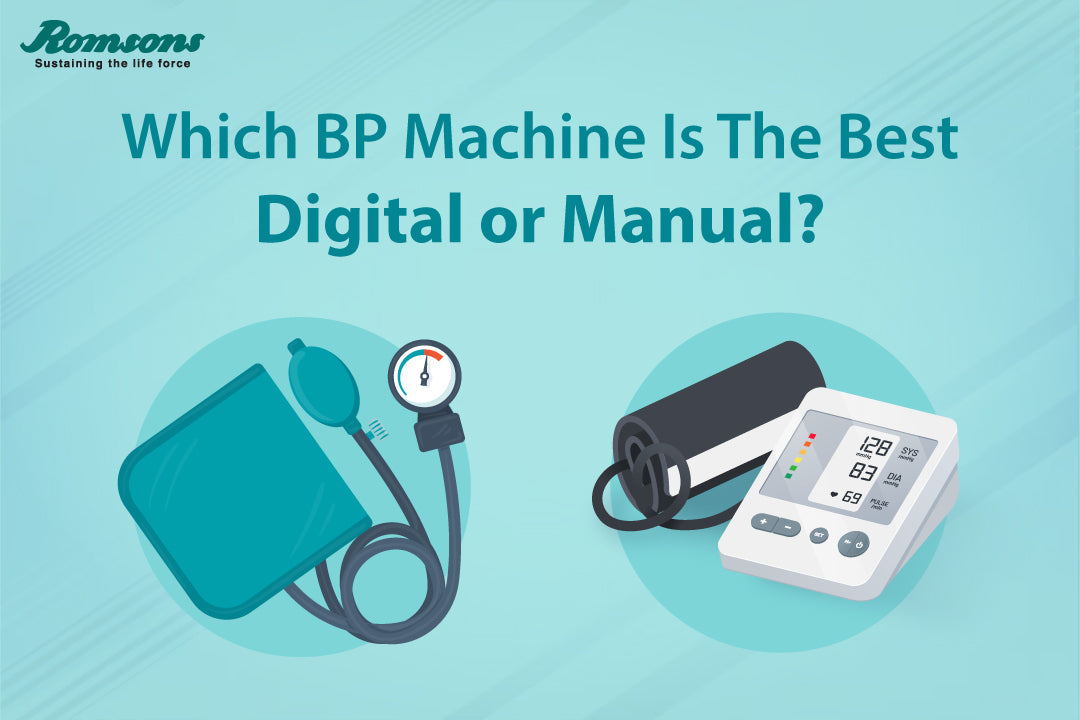Which BP Machine Is The Best—Digital or Manual?

High blood pressure (hypertension) is one of the most common health issues globally, often called the “silent killer” because it can cause severe health problems—such as heart disease, stroke, and kidney complications—without noticeable symptoms. To manage hypertension effectively, regular blood pressure monitoring is essential.
But here’s the big question: Which blood pressure machine is better—digital or manual? Both have their advantages and limitations. Let’s compare them so you can make the right choice for your health and home.
What Is Blood Pressure Monitoring?
Blood pressure is measured in millimeters of mercury (mmHg) and expressed as two values:
-
Systolic Pressure (top number): The pressure when your heart beats.
-
Diastolic Pressure (bottom number): The pressure when your heart rests between beats.
Example: 120/80 mmHg is considered a normal reading.
Consistently high readings may indicate hypertension, a key risk factor for cardiovascular diseases. Monitoring blood pressure at home gives you valuable insights and helps your doctor track your condition over time.
Digital Blood Pressure Machines: The Modern Solution
Digital blood pressure monitors, also called automatic BP machines, have become very popular because of their ease of use and accuracy.
Advantages of Digital BP Monitors
-
Ease of Use: Just wrap the cuff, press a button, and the machine does the rest.
-
Quick Results: Provides instant readings in under a minute.
-
Accuracy: Advanced sensors minimise human error.
-
Memory Function: Stores multiple readings for tracking blood pressure trends.
-
Portability: Compact and lightweight, ideal for home use and travel.
Disadvantages of Digital BP Monitors
-
Requires batteries or electricity.
-
Can be slightly more expensive than manual options.
-
Accuracy may vary if used incorrectly (wrong cuff size, wrong arm position).
Best for: People who want a hassle-free, quick, and modern way to track blood pressure at home.
Manual Blood Pressure Cuffs: The Traditional Approach
Manual BP machines (sphygmomanometers) are the traditional choice and are still widely used by doctors and nurses.
Advantages of Manual BP Monitors
-
High Accuracy: Considered the “gold standard” when used correctly.
-
Reliable: No batteries or electricity needed.
-
Durable: Long-lasting and sturdy design.
-
Affordable: Generally cheaper than digital monitors.
-
Professional Use: Preferred by healthcare professionals for precision.
Disadvantages of Manual BP Monitors
-
Requires training to use correctly (stethoscope needed).
-
Takes longer compared to digital monitors.
-
Not very convenient for self-monitoring at home.
Best for: Healthcare professionals or individuals who value accuracy over convenience.
Digital vs Manual BP Machine: Which Should You Choose?
The choice between digital and manual BP machines depends on your lifestyle, budget, and medical needs.
Choose Digital If:
-
You want convenience and speed.
-
You need to store readings for trend analysis.
-
You prefer a user-friendly option without medical training.
-
You want a portable device for home and travel.
Choose Manual If:
-
You want the highest accuracy possible.
-
You are a healthcare professional (or trained to use it).
-
You want a budget-friendly, long-lasting device.
-
You don’t mind the extra time and effort.
Ultimately, the best BP machine is the one you use regularly and correctly.
Romsons Digital Blood Pressure Monitors: Technology Meets Precision
In the world of modern healthcare, Romsons has emerged as a trusted leader in medical devices. Their digital BP machines combine precision, ease of use, and innovation, making them an excellent choice for home monitoring.
Here are two of their most popular models:
Romsons BPX PLUS Blood Pressure Monitor
-
Fully automatic digital BP machine.
-
Doctor-recommended for accurate and dependable readings.
-
Wide LCD display shows systolic, diastolic, and pulse rate clearly.
-
120-memory storage capacity to track long-term readings.
-
Compact and portable for home or travel use.
Perfect for people who want consistent, professional-grade readings at home.
Romsons BP-10 Automatic Digital BP Monitor
-
Designed with advanced digital technology for reliable readings.
-
Large, easy-to-read display for quick interpretation.
-
60-memory function for monitoring changes over time.
-
User-friendly interface, even for beginners.
-
Comfortable, adjustable cuff suitable for most arm sizes.
Great for individuals who need a simple, everyday monitor without complexity.
FAQs About BP Machines
1. Which type of BP machine is more accurate?
-
Manual sphygmomanometers are considered the gold standard. However, modern digital monitors are highly accurate when used properly.
2. Can I rely on digital BP monitors at home?
-
Yes, especially if you use them with the correct cuff size and proper posture. They are recommended for regular monitoring.
3. Are manual BP machines cheaper than digital ones?
-
Yes, manual machines are generally more affordable but require training to use correctly.
4. Which BP machine is best for seniors?
-
Digital BP monitors are better for seniors due to their ease of use and readability.
5. How often should I check my blood pressure at home?
-
For hypertension patients: once daily or as recommended by your doctor. For general health: a few times per week is sufficient.
So, which BP machine is best—digital or manual?
-
If you want ease, convenience, and smart features, go for a digital BP monitor.
-
If you want highest accuracy, durability, and affordability, choose a manual cuff.
At the end of the day, what matters most is regular monitoring and using the device correctly. If you’re still unsure, talk to your doctor before making a decision.
For those looking for a reliable, easy-to-use option, Romsons Digital BP Monitors (BPX PLUS and BP-10) are excellent choices. They combine innovation, accuracy, and comfort, helping you stay on top of your health from the comfort of your home.
Check out the full range of Romsons Digital Blood Pressure Monitors [Click Here]

